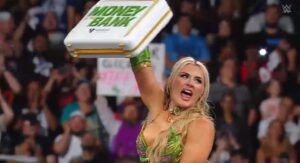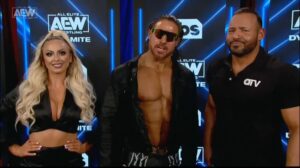Throughout Pride Month this June, we’ll be working on new features to highlight personalities throughout the wrestling industry, from its storied past to its bright future, who identify as part of the LGBTQ+ community. In this feature, we look at one of the first openly gay men to take part in Mexico’s historic exóticos division, in LGBTQ+ pioneer in Mexico, Babe Sharon.
In Mexico, wrestling personalities are divided into styles. Técnicos are considered the “good guys” or babyfaces, while Rudos are the “bad guys” or heels. Mini-Estrella (or simply “Minis”) are smaller luchadores either little people or just below average wrestlers, while some wrestlers employ the deeply rooted tradition of wearing máscara (masks). But one of Lucha Libre’s most unique styles is that of the exótico. Started in the 1940s in Mexico, the exótico style was purely based on flamboyant entertainment. One of its pioneers, Texas-born Gardenia Davis, was more aligned with the likes of Gorgeous George or Ric Flair than future exótico legends like Cassandro or Pimpinela Escarlata. It was more about flamboyant showmanship than it was about any kind of sexual identity. And despite Davis’ success in launching an entirely new scene in Mexican wrestling, in the US the gimmick was dead in the water (in the US, he competed as Dizzy Davis). He was so sure the gimmick wouldn’t work that he handed over the idea to his childhood friend George Wagner, who became Gorgeous George.

But as the exótico characters evolved, the flamboyant cockiness became more and more replaced by simulations of homosexuality. But while the motivations were to enrage more heat from audiences due to a then-cultural bias against those of the LGBTQ+ community, many of these gestures were more damning to the actual members of the community than they were positives. Until Armando Octaviano Haro Viramontes came along, that is.

Armando Octaviano Haro Viramontes was born in June 18, 1954, in Zacatecas, Mexico, and originally began competing in Mexican lucha libre as Guerrero Samurai. Trained by his father, a luchadore known as Carrillo, and early lucha star Diablo Velasco, Armando became a gifted grappler. But unbeknownst to many of Armando’s fans, peers, and family, he was a homosexual gay man. In the mid-1970s, he finally came out and in doing so, would change the course of the exóticos. “Baby Sharon [sic] came out in the seventies,” exótico icon Cassandro told The New Yorker in 2014. “It was really difficult then. He was a tough cabrón. Every exótico that started had to go through him.” Babe Sharon would go on to work with multiple Mexican promotions throughout the 1970s and 1980s, such as Universal Wrestling Association (UWA).

Becoming Babe Sharon, he would finally become the wrestler that truly exemplified his true self, combining flamboyance with a sneering desire to over-feminize to antagonize the very audience that jeered him. His actions became acts of defiance against those who condemned the LGBTQ+ community, instead of acts of encouragement as previous heterosexual exóticos had partaken. Sharon’s willingness to not only embrace his own homosexuality in a “macho” industry like lucha libre but to bring a division initially designed to mock those of the LGBTQ+ community inspired future generations of exóticos. In the mid-70s, Rudy Reyna would emerge as another pioneer of the exóticos style, whose own homosexuality had gotten him several backstage fights with the likes of Dr. Wagner and Villano I. Reyna would go on to form the influential Los Exóticos stable that included future legends like Pimpinela Escarlata and May Flowers as well as invent the “kiss spot” of planting a big kiss on your opponent, that has been used throughout wrestling since from the US to Japan.

Babe Sharon would also have a hand in shaping the career of Cassandro. When Cassandro debuted in 1988, he was a far different character than the ostentatious exótico icon we know today. He began as the Roman gladiator-inspired Mr. Romano, trained by the original Rey Misterio (uncle to the WWE and WCW Superstar Rey Mysterio Jr.). As someone who had previously embraced a warrior style gimmick before accepting themselves, Babe Sharon “encouraged me to step out of Mister Romano” Cassandro recalled in his interview with the New Yorker. This lead to him becoming Rosa Salvaje, his first transition into becoming a proper exótico. But even then, his style was still more straight-laced. It was only after losing a lucha de apuesta (betting match) where he put his name on the line against Johnny Vannessa – which he lost – that he would begin his path as arguably the most famous exótico of all time.

As for Babe Sharon, he would jump to the new Asistencia Asesoría y Administración (AAA) in 1992, where he would compete into the late 1990s, and then continue to remain involved as a trainer. One of Babe Sharon’s most famous pupils is the current lucha madman Pagano. In 2008, Babe Sharon sadly passed away at the age of 53. But his coming out in the mid-1970s had never fully healed with members of his family. “We buried him in Juárez,” Cassandro told the New Yorker. “We called his family in Guadalajara, but his daughter didn’t even tell her family that he died. They were ashamed of him.” A sad ending for a man who had been one of the first men to find the courage to be themselves in an industry that mocked them not only backstage or at the bar, but had built an entire division around their ridicule. But Babe Sharon’s influence on future exóticos – and lucha libre itself – is undeniable.

Stay tuned to the Last Word on Pro Wrestling for more on this and other stories from around the world of wrestling, as they develop. You can always count on LWOPW to be on top of the major news in the wrestling world, as well as to provide you with analysis, previews, videos, interviews, and editorials on the wrestling world.






